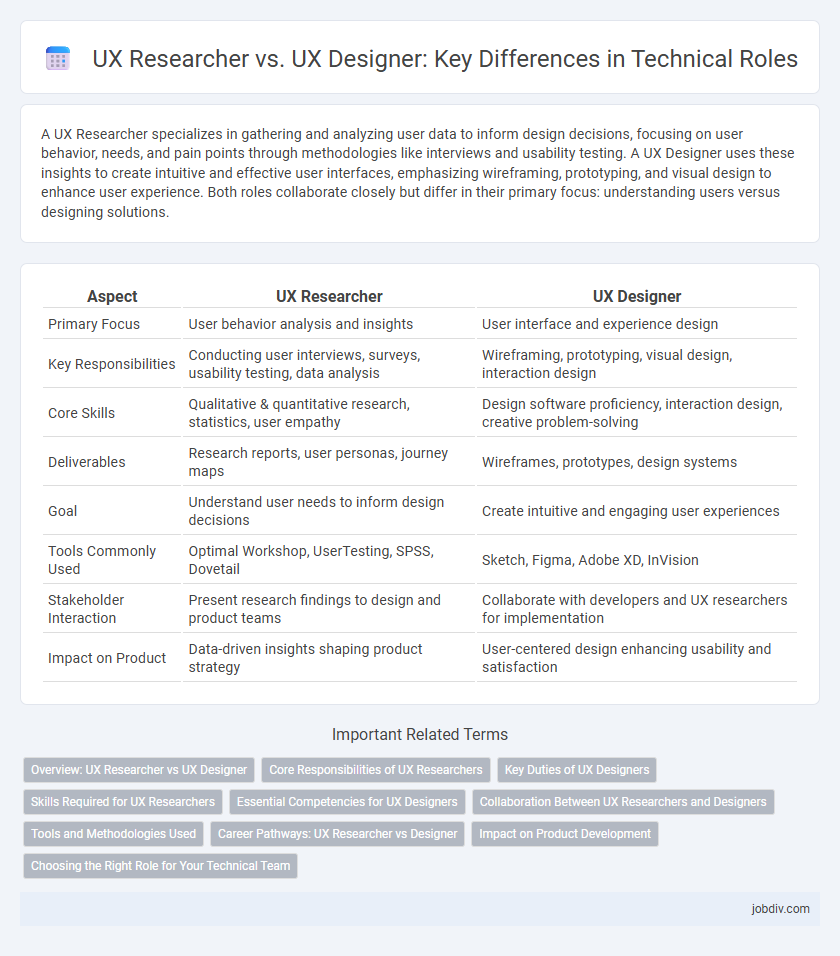A UX Researcher specializes in gathering and analyzing user data to inform design decisions, focusing on user behavior, needs, and pain points through methodologies like interviews and usability testing. A UX Designer uses these insights to create intuitive and effective user interfaces, emphasizing wireframing, prototyping, and visual design to enhance user experience. Both roles collaborate closely but differ in their primary focus: understanding users versus designing solutions.
Table of Comparison
| Aspect | UX Researcher | UX Designer |
|---|---|---|
| Primary Focus | User behavior analysis and insights | User interface and experience design |
| Key Responsibilities | Conducting user interviews, surveys, usability testing, data analysis | Wireframing, prototyping, visual design, interaction design |
| Core Skills | Qualitative & quantitative research, statistics, user empathy | Design software proficiency, interaction design, creative problem-solving |
| Deliverables | Research reports, user personas, journey maps | Wireframes, prototypes, design systems |
| Goal | Understand user needs to inform design decisions | Create intuitive and engaging user experiences |
| Tools Commonly Used | Optimal Workshop, UserTesting, SPSS, Dovetail | Sketch, Figma, Adobe XD, InVision |
| Stakeholder Interaction | Present research findings to design and product teams | Collaborate with developers and UX researchers for implementation |
| Impact on Product | Data-driven insights shaping product strategy | User-centered design enhancing usability and satisfaction |
Overview: UX Researcher vs UX Designer
UX Researchers focus on gathering and analyzing user data through qualitative and quantitative methods to inform design decisions, emphasizing user behavior and needs. UX Designers translate research insights into wireframes, prototypes, and high-fidelity designs that enhance user interaction and visual appeal. Both roles collaborate closely to optimize user experience by blending empirical evidence with creative design solutions.
Core Responsibilities of UX Researchers
UX Researchers focus on gathering and analyzing user data to inform design decisions, employing methods such as user interviews, usability testing, and surveys to uncover user needs and behaviors. They translate qualitative and quantitative insights into actionable recommendations that enhance product usability and user satisfaction. This research-driven approach ensures that UX Designers have a data-backed foundation to create intuitive and effective user interfaces.
Key Duties of UX Designers
UX Designers primarily focus on creating intuitive and visually appealing interfaces by conducting user research, wireframing, prototyping, and usability testing to ensure seamless user experiences. They translate user needs and business goals into interactive designs that enhance product functionality and accessibility. Collaboration with developers and stakeholders is essential to refine design solutions and maintain consistency across platforms.
Skills Required for UX Researchers
UX Researchers require strong analytical skills and proficiency in qualitative and quantitative research methodologies to gather and interpret user data effectively. Expertise in tools such as user interviews, surveys, usability testing, and data analysis software like SPSS or Excel is essential to identify user needs and behaviors. Strong communication skills are critical for translating research findings into actionable insights that guide UX Designers in creating user-centered interfaces.
Essential Competencies for UX Designers
UX Designers require competencies in user interface design, interaction design, and visual communication to create intuitive and aesthetically pleasing products. Mastery in prototyping tools, user-centered design principles, and usability testing techniques is essential for refining product flow and enhancing user satisfaction. Collaboration skills with cross-functional teams and knowledge of front-end development further empower UX Designers to implement feasible and innovative design solutions.
Collaboration Between UX Researchers and Designers
Effective collaboration between UX researchers and UX designers is essential for creating user-centered products that meet both usability and aesthetic goals. UX researchers provide data-driven insights and user behavior analysis, which inform UX designers in crafting intuitive interfaces and seamless user experiences. This synergy accelerates the design iteration process and enhances product success by aligning functionality with user needs.
Tools and Methodologies Used
UX Researchers primarily utilize tools like user interviews, surveys, and usability testing software such as Optimal Workshop and UserTesting to gather qualitative and quantitative data on user behavior. UX Designers focus on design and prototyping tools including Sketch, Figma, and Adobe XD to create user interfaces based on insights derived from research. Methodologies for UX Researchers often include ethnographic studies and heuristic evaluation, while UX Designers emphasize wireframing, interaction design, and iterative prototyping processes.
Career Pathways: UX Researcher vs Designer
Career pathways for UX Researchers often involve progressing from entry-level research roles to senior researcher or UX research manager positions, emphasizing expertise in qualitative and quantitative user data analysis. In contrast, UX Designers typically advance from junior design roles to lead designer or UX design manager roles, focusing on creating user-centered interfaces and improving interaction design. Both careers require continual skill development, but UX Researchers lean towards behavioral research methods while UX Designers prioritize prototyping and visual design skills.
Impact on Product Development
UX Researchers provide critical insights into user behaviors and needs through data-driven methods, directly influencing product decisions and prioritization. UX Designers translate these insights into intuitive interfaces and user flows, shaping the product's usability and aesthetic appeal. Together, their collaboration accelerates development cycles and enhances overall product quality by ensuring user-centric solutions.
Choosing the Right Role for Your Technical Team
Selecting the right role between a UX Researcher and a UX Designer depends on your technical team's project needs and objectives. UX Researchers specialize in data-driven user insights, employing methods like user interviews, usability testing, and behavior analysis to inform product development. UX Designers focus on creating intuitive interfaces, leveraging wireframes, prototyping, and interaction design to improve user experience and visual appeal.
UX Researcher vs UX Designer Infographic

 jobdiv.com
jobdiv.com